|
|
Post by el3637 on May 31, 2012 21:51:22 GMT -8
I already have discussed this on the PCL and D-list but it was suggested that I post it here too. Just something to be aware of if you have any Walthers plated passenger cars. I ran my El Capitan for the first time Sunday, and the short form of the story is... train ground to a halt after a while, and the baggage dorm was making a sizzling sound. The sound a DCC signal makes when it's shorting. The baggage end of the car was warm... and showed some signs of melting. The long and the short of it is... the plating conducts electricity. It's actually copper plated under the chrome (or whatever the final finish is). The Walthers cars pick up from both sides, into metal weights in the floor. There are two strips of stainless (I think it's stainless, it won't solder) attached on the ends to feed current to the optional light bar. Well these contacts rest against the car end, and apparently on the plated car are supposed to be insulated by a piece of clear tape. Except when they're not. Take a look at the outcome: 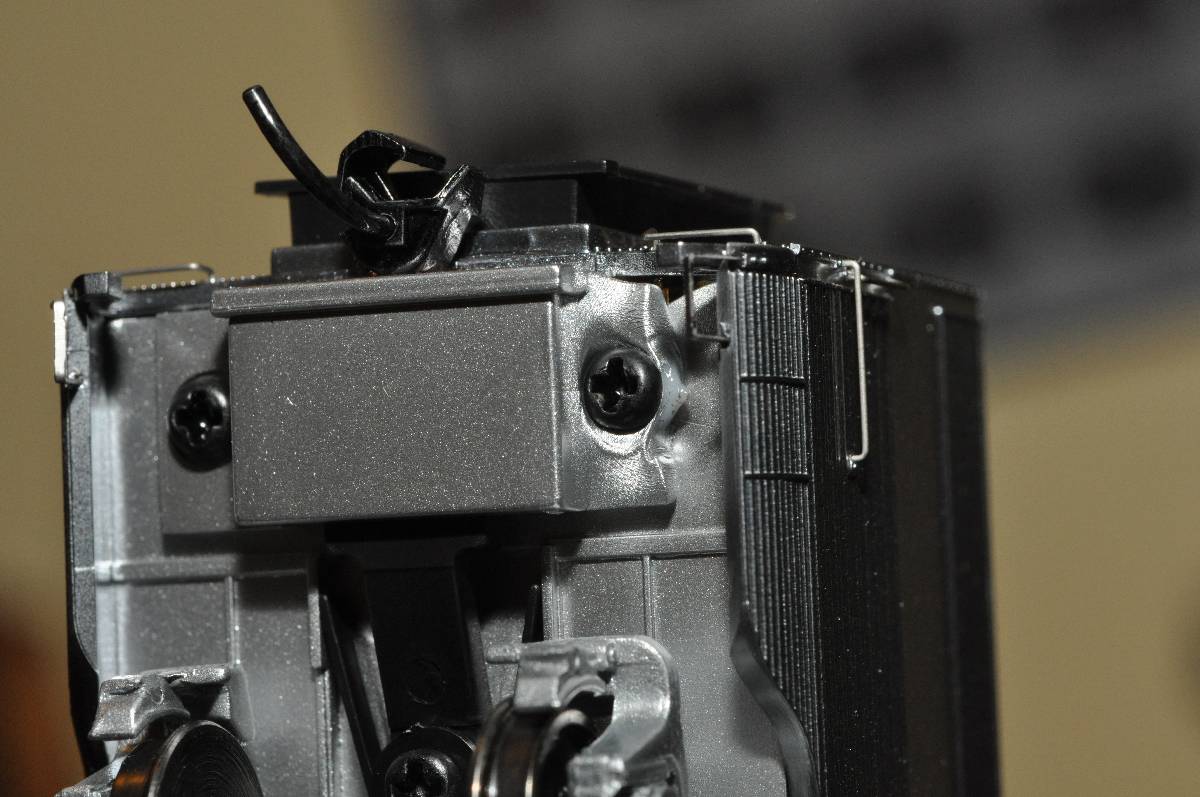 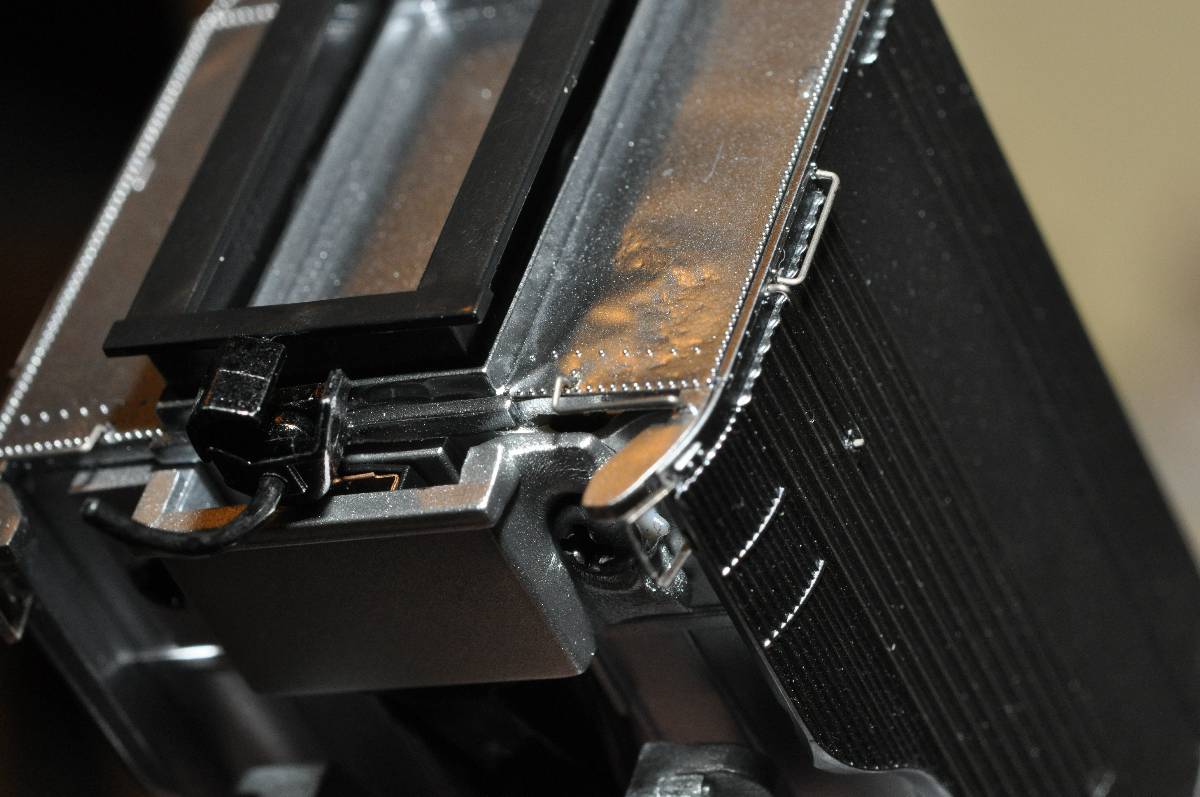 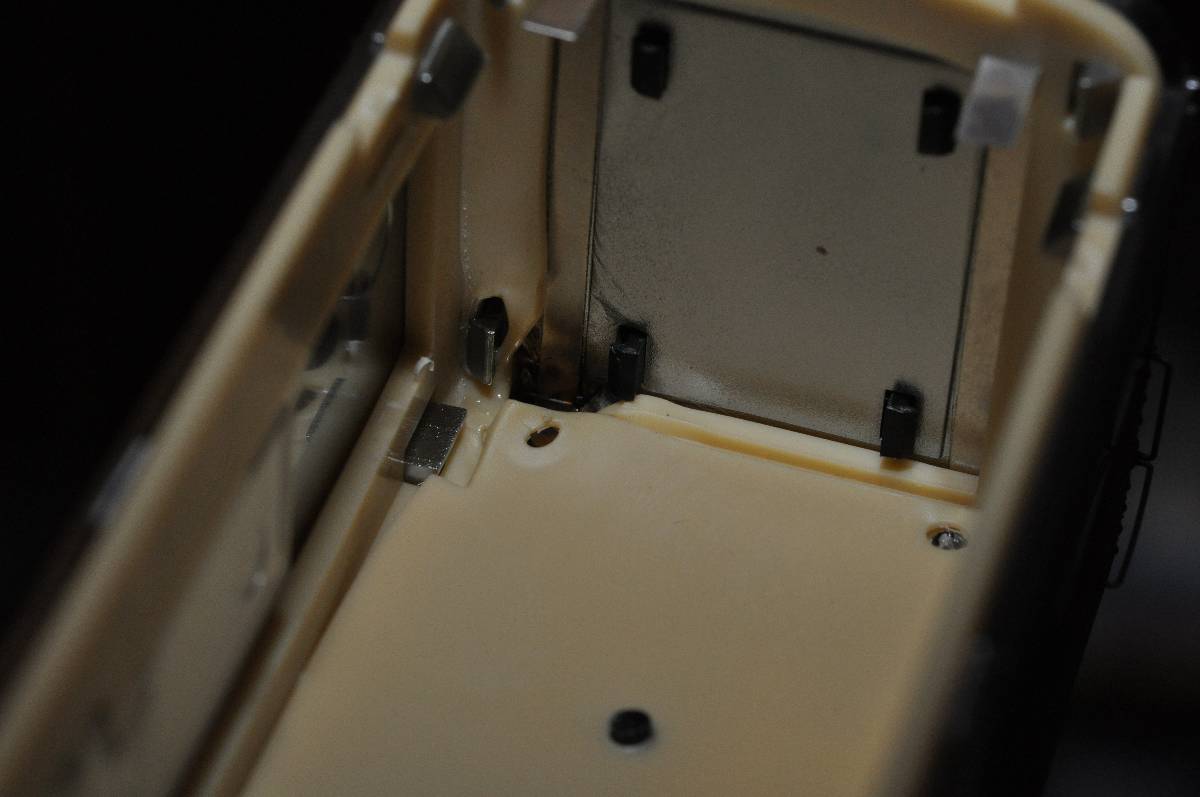 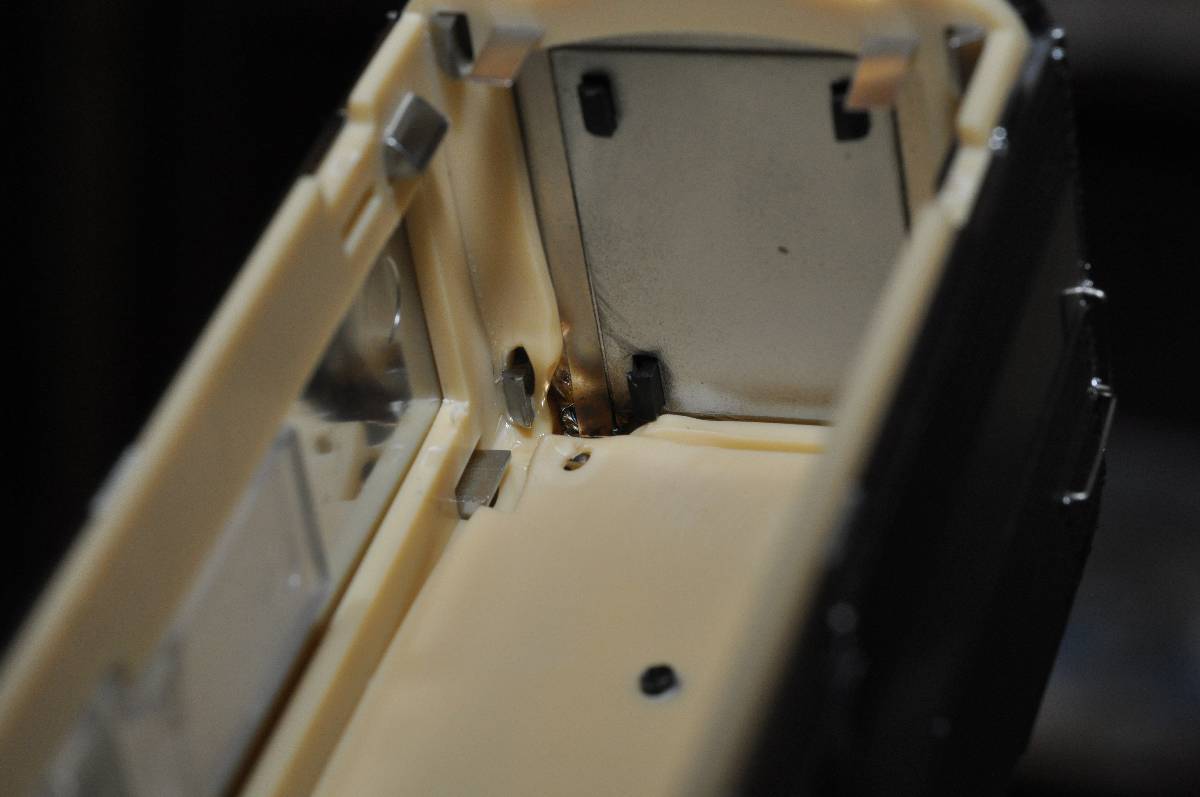 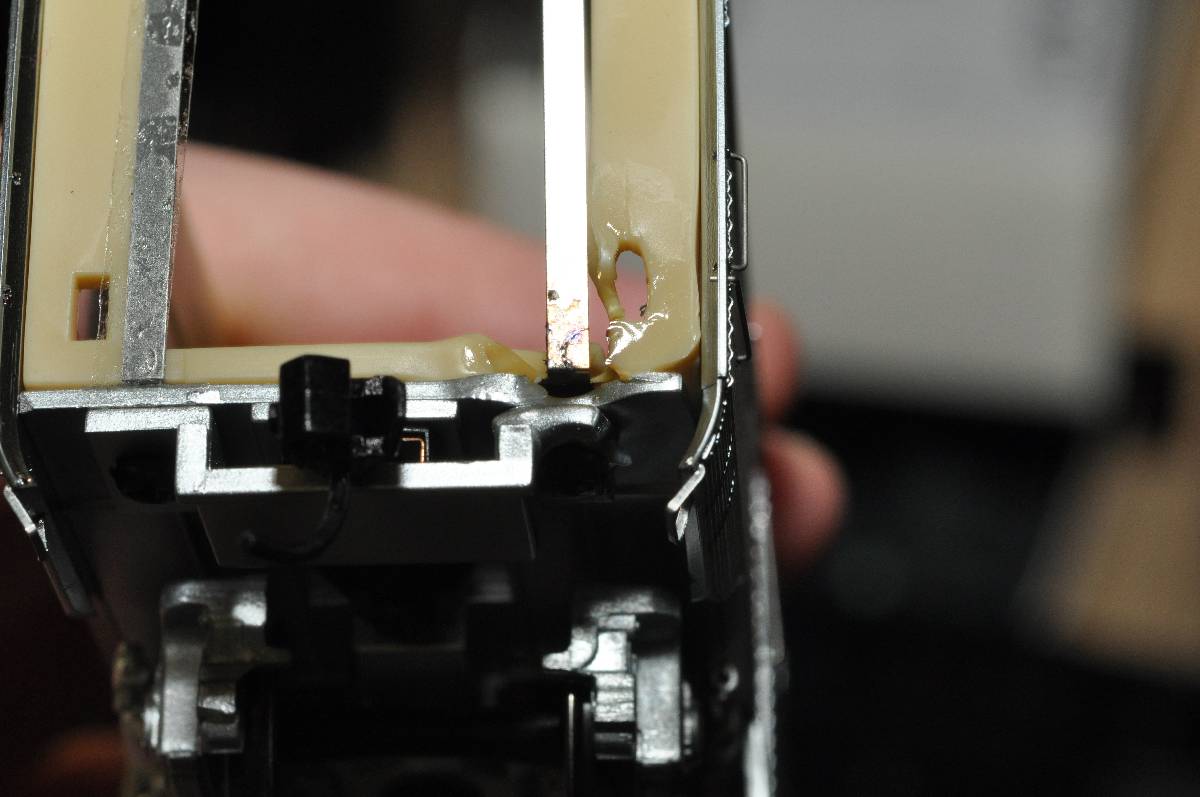 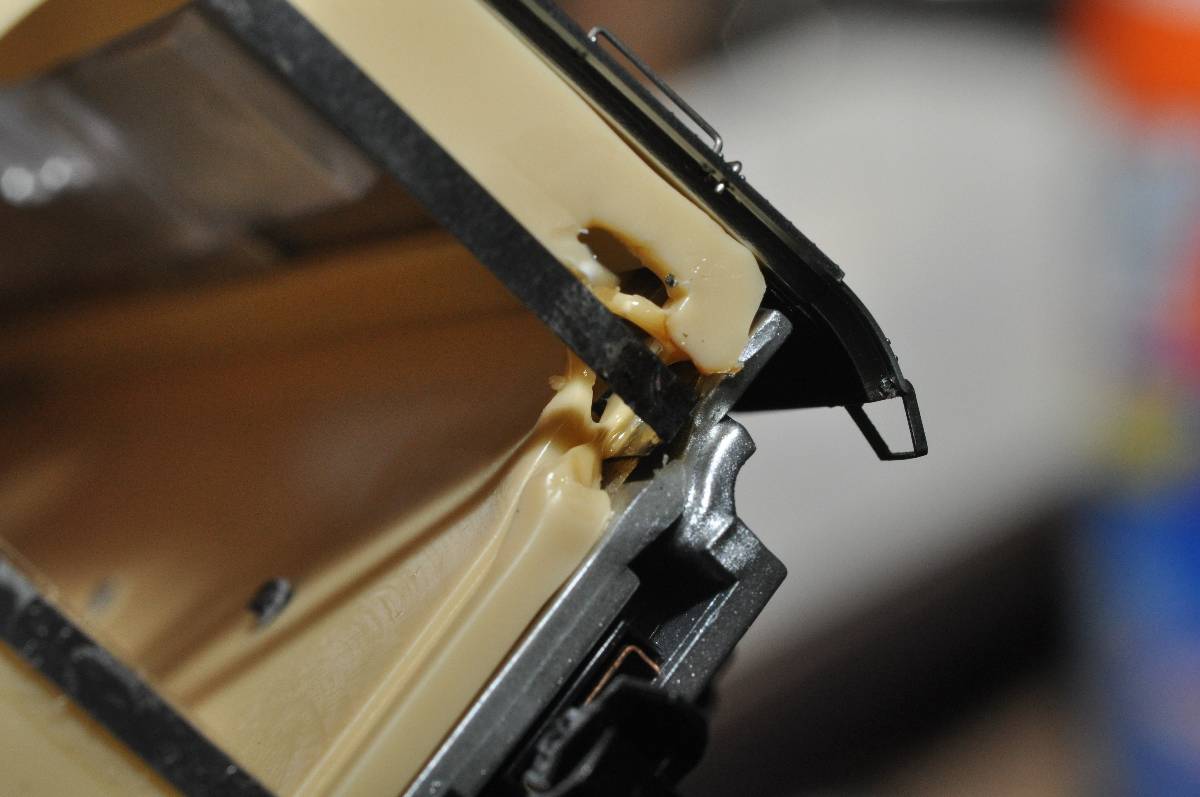 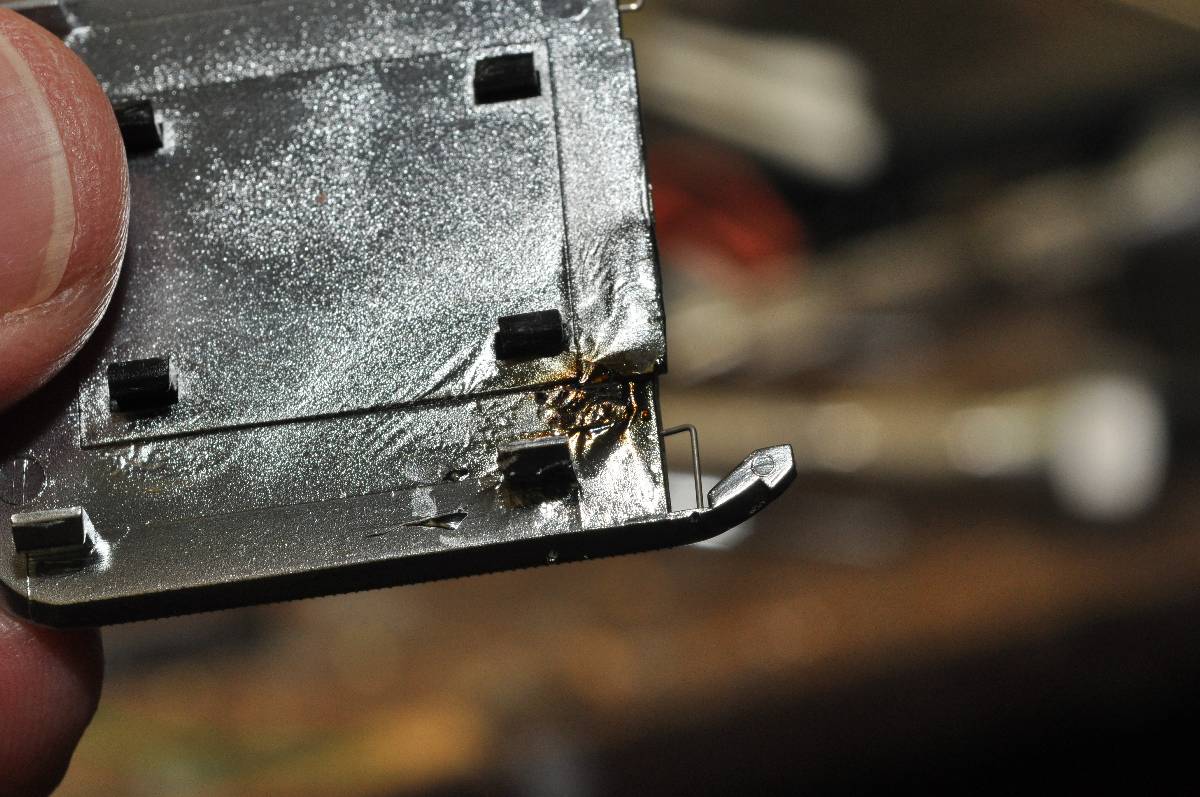 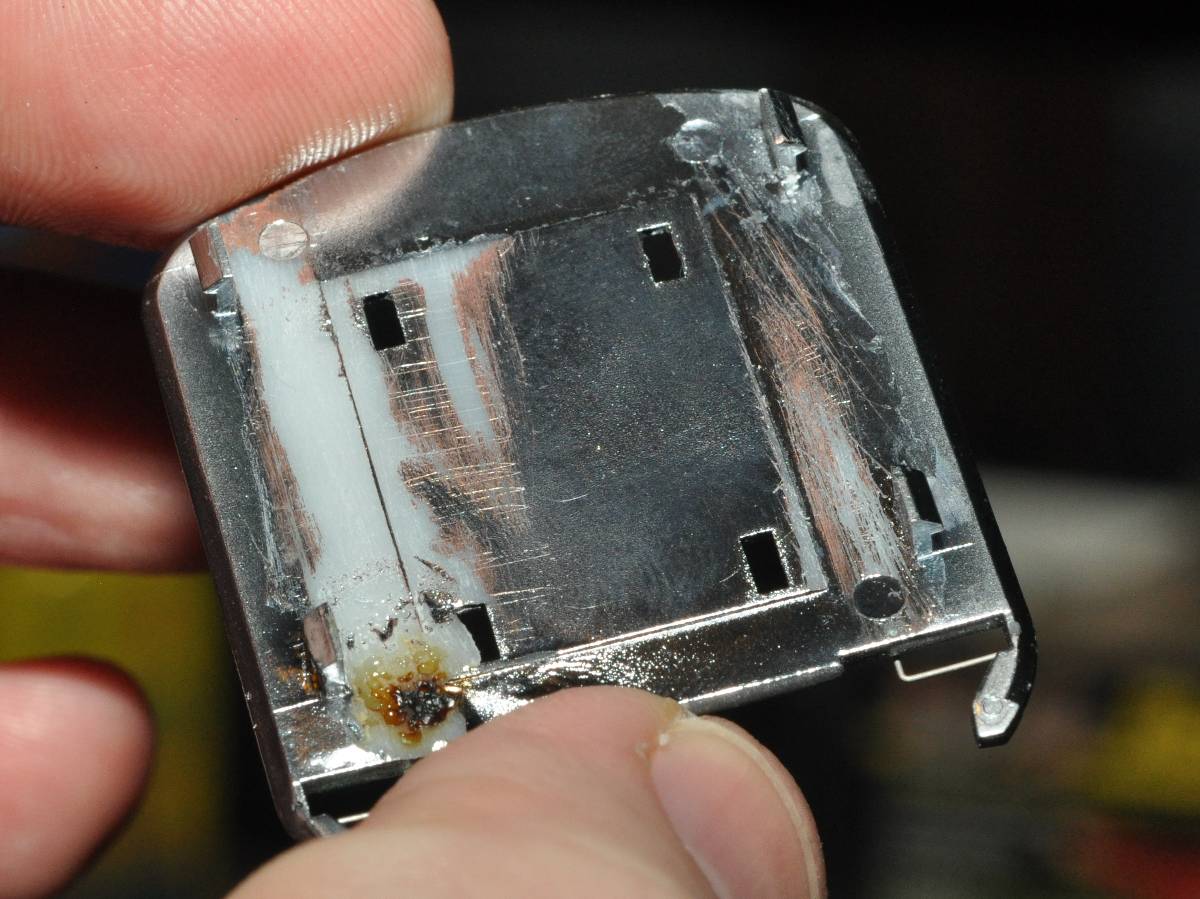 The last pic is after I attempted to sand off the plating. The stuff is tough! And you can see the copper underneath. It's NOT the normal "chrome" plating like you'd see on a plastic model car or airplane (which is also conductive I believe). Typical chrome plating will easily strip with oven cleaner. The OC wouldn't touch this stuff. I wound up just using black tape to insulate it and that fixed it. The damage isn't really visible except the slight blistering on the end. Just a word of warning - I'd recommend any Walthers plated car should get tested on a test track for current draw. Without lights they should not draw any current at all. If they do... pop the top and pop the ends, and insulate. Maybe pop the ends and check anyway. Mine operated for 30+ minutes without seemingly any problems - although it may have been intermittently blipping the DCC track current and making he locos act up, which I attributed to Genesis dirty contact syndrome on the F units. So it's possible the car might pass the test initially but then a bump or vibration and it make contact. I figure once it made contact it started heating up, and resistance increased... it got hot enough to melt the plastic and scorch the chrome as you can see in the pics. For all the issues I had with the Rapido Canadian, at least it didn't catch on fire :-) I imagine this is more of a hazard with DCC since it's always running 12-14 volts to the rails. Andy |
|
|
|
Post by calzephyr on Jun 1, 2012 5:55:24 GMT -8
Andy
Thanks for bringing this to our attention. Is the car in question a non lighted car? The tabs would be there for either so the problem could show up on any of the cars if I read this correctly.
I will deactivate the voltage pickups on my cars before they are used on a layout. Thanks for showing the results.
Larry
|
|
|
|
Post by loudigrazia on Jun 1, 2012 6:00:58 GMT -8
Andy, have you contacted Walthers about this issue? I think I'd take the same path you did with repairing the car myself, but it seems that this problem could be a potential hazard in addition to ruining one's investment!
Lou DiGrazia
|
|
|
|
Post by Paul Cutler III on Jun 1, 2012 6:51:30 GMT -8
Wow. I've seen a DCC engine melt, but never an unlit passenger car. Why do you always get the "special" ones, Andy?  Larry, You can't "deactivate" the electrical pickup on a Walthers car short of tearing the car apart down to the frame or replacing the wheelsets or trucks. The metal wheelsets conduct electrically to the axle ends, which energizes the metal truck sideframes. The sideframes are screwed into a plastic bolster with 2 phillips screws each. The tops of these screw heads rub the bottom of a metal plate and give the car stability. These plates are connected to the metal strips that "snake head" at the end of the car as shown in Andy's pics. As I see it, you can't remove the screws or metal car body bolster plates because that will adversely affect the stability of the car. It would rock side to side like the worst kind of Tyco junk going down the track, IOW. To cut out the power to these strips in the floor, you have to either tear the car down and either cut or remove them, or you'd have to replace all the wheelsets with ones that won't conduct power to both axle ends, or you have to replace the trucks with plastic ones. Whatever you do, it ain't gonna be easy...that's for sure.  |
|
|
|
Post by calzephyr on Jun 1, 2012 7:20:44 GMT -8
Wow. I've seen a DCC engine melt, but never an unlit passenger car. Why do you always get the "special" ones, Andy?  Larry, You can't "deactivate" the electrical pickup on a Walthers car short of tearing the car apart down to the frame or replacing the wheelsets or trucks. The metal wheelsets conduct electrically to the axle ends, which energizes the metal truck sideframes. The sideframes are screwed into a plastic bolster with 2 phillips screws each. The tops of these screw heads rub the bottom of a metal plate and give the car stability. These plates are connected to the metal strips that "snake head" at the end of the car as shown in Andy's pics. As I see it, you can't remove the screws or metal car body bolster plates because that will adversely affect the stability of the car. It would rock side to side like the worst kind of Tyco junk going down the track, IOW. To cut out the power to these strips in the floor, you have to either tear the car down and either cut or remove them, or you'd have to replace all the wheelsets with ones that won't conduct power to both axle ends, or you have to replace the trucks with plastic ones. Whatever you do, it ain't gonna be easy...that's for sure.  Paul You are right about the system being used for the stability of the car and most of that has to stay the way it is. If the tabs at the end can be isolated so they cannot rub against the plating on the end of the car, that should solve the problem. This could happen to the lighted ones or the non lighted cars if I understand the problem correctly. If tape can be used to isolate that metal coating from the two tabs, that would prevent the high resistance and the shorting out of the DCC voltage. This could also cause problems with DC if the train was run at faster speeds since the higer voltage over a period of time probably might cause the same breakdown and short out. It could be the way the tabs are bent since only one of Andy's cars shorted out. It it was the diner, the sizzle would have been realistic, since steaks were frying on the Grill!!!!! Larry |
|
|
|
Post by KIM on Jun 1, 2012 9:56:02 GMT -8
It goes to show that no matter how careful you are, something can still bite you. This is something I never would have thought of.
|
|
|
|
Post by calzephyr on Jun 1, 2012 14:23:55 GMT -8
I was thinking about the problem and wondered if this short will show up on any other cars that are being run on layouts. This is the first reported and I did see a video that Jim found and linked to showing both the Super Chief and the new El Cap running on a layout. It is obvious that this is a problem but how many others will show up or has already and they are not on the forum. I did not read anything on the Trains.com for model railroad or Train Orders section for Model railroads. I doubt it is a one only type of problem.
I used an Ohm meter on the car surface and the plated surface is dead short and anyplace the voltage touches the plating will be a problem. The bottom of the car is not plated so I am not sure where the contact was made on Andy's car.
After looking at the contacts inside the 700 series coach, they do not seem to have the possiblity of having this problem like the baggage car and possibly the RPO. I have taken those apart.
One thing is for sure, the plating is a great conductor and voltage that comes into contact with it can and will cause problems.
After checking the drawings, it would seem only the single level cars could have this problem if the drawings are correct. The baggage dorm has the metal flat leads running up the inside of the plated end piece which is a direct short if no insulation is between them and the metal plating. The regular high level cars should not have this problem if the drawings are correct.
The El Cap RPO and baggage cars could have this problem also if they have the flat voltage leads at one end next to the end plating. If those flat leads are removed, the problem should be solved.
The plated Super Chief cars with the flat leads could also fail it the leads touch the ends and short out.
Larry
|
|
|
|
Post by antoniofp45 on Jun 1, 2012 15:52:47 GMT -8
Andy, Good service you're providing to fellow passenger car modelers with this info. You're not trying to put Walthers down, just pointing out a significant "bug" that needs attention. Your photos speak strongly. Hopefully Walthers' rep has seen this thread and will pass it on to the appropriate people to work on a design change to prevent this potential bugger from popping up on future releases. BTW: This thread has attracted attention on the Railroad Line Forum as well. Modeler K9Wrangler posted a link to it. High Greens  |
|
|
|
Post by rhpd42002 on Jun 1, 2012 17:25:11 GMT -8
Good "catch" Andy and glad you found it and posted your experience. Not sure if any Walthers' reps are reading, so I hope you are letting them know about it. Not sure I'll ever own any of those cars, but nice that you've also found a "fix" and shared it, too.  That what makes places like this a valuable resource for both modelers and manufacturers, should they choose to peruse some of the more active Forums. Like this one is becoming!!  Sounds like someone had an "unauthorized" hot plate in the Dorm!! ;D |
|
|
|
Post by el3637 on Jun 1, 2012 20:48:29 GMT -8
The bottom of the car is not plated so I am not sure where the contact was made on Andy's car. I'm sure... look at the pictures again. The inside of the ends are plated, and up against the vertical strips. I think Walthers intended to tape both strips to insulate, but only one was taped and apparently made contact at some point anyway. The one which was not taped is clearly the one that heated up and melted the car. Any other low-level car with plating could potentially have this problem. In fact in a few minutes I am going to pop apart a Regal plated 4-4-2 for a look and also take a look at the plated Pleasure dome which I have already disassembled some months ago. Andy |
|
|
|
Post by el3637 on Jun 1, 2012 20:51:34 GMT -8
Sounds like someone had an "unauthorized" hot plate in the Dorm!! ;D This one had a better outcome than the P2K Wabash GP7 with the PNP NCE decoder. That decoder melted down enough to melt the shell to where a little ripple is visible on the outside. That is the absolute last vintage P2K loco to get a decoder without having its motor replaced. Newer (post Walthers) seem to be a better risk. Andy |
|
nhguy
New Member

Posts: 15
|
Post by nhguy on Jun 1, 2012 21:13:50 GMT -8
All I have to say is: Holy Cow! It seems they have a BIG problem on their hands.
|
|
Deleted
Deleted Member
Posts: 0
|
Post by Deleted on Jun 2, 2012 4:43:08 GMT -8
Andy,
The bag dorm is still available from Walthers. If I were you I'd take the Post Toastie back to the dealer and have them get you a new car. The other other alternative is to send the car back to Walthers with about a four page dissertation that will be as hot as the car got! Let Walthers suck up THEIR problem and make it RIGHT TO YOU!
You paid GOOD MONEY for that model and shouldn't have to be trying to fix a problem that is that major in scope.
|
|
|
|
Post by calzephyr on Jun 2, 2012 5:24:00 GMT -8
The bottom of the car is not plated so I am not sure where the contact was made on Andy's car. I'm sure... look at the pictures again. The inside of the ends are plated, and up against the vertical strips. I think Walthers intended to tape both strips to insulate, but only one was taped and apparently made contact at some point anyway. The one which was not taped is clearly the one that heated up and melted the car. Any other low-level car with plating could potentially have this problem. In fact in a few minutes I am going to pop apart a Regal plated 4-4-2 for a look and also take a look at the plated Pleasure dome which I have already disassembled some months ago. Andy Andy All of the car which have the flat voltage leads at the end of the car on the inside of the end are subject to this problem. The previous Super Chief cars that were plated could have the problem also since they had the vertical leads that could touch the end plating. I had removed the end pieces on some of my El Cap High level cars and they don't have the leads running up the end of the car. The High level cars have the leads inside the interior and the bottom of the High level El Cap cars are painted so they would not be subject to the problem. Thanks for posting this information and sending the post to Walthers customer service is a great idea. Larry |
|
|
|
Post by mlehman on Jun 2, 2012 7:09:21 GMT -8
re real metal plating and smoking non-smoker cars.... "Don't you think this prototype [stuff} dun got outta hand?" - Waylon Waymore  Sorry, just had to say it after all the discussion over whose plating is best, is it real plating? etc. Walthers 2013 Slogan "When they start catching fire, you know it's just like the real thing!"  ;D |
|
|
|
Post by calzephyr on Jun 2, 2012 8:07:08 GMT -8
re real metal plating and smoking non-smoker cars.... "Don't you think this prototype [stuff} dun got outta hand?" - Waylon Waymore  Sorry, just had to say it after all the discussion over whose plating is best, is it real plating? etc. Walthers 2013 Slogan "When they start catching fire, you know it's just like the real thing!"  ;D That is a great observation since many posts complained about this not being correct. It is metal for sure as my Ohm meter shows a dead short on any portion of the plating. It is real!!! Larry |
|
|
|
Post by kentuckysouthernrwy on Jun 2, 2012 11:49:22 GMT -8
I took my baggage dorm apart and there is only tape on one side. I haven't put it on track yet. 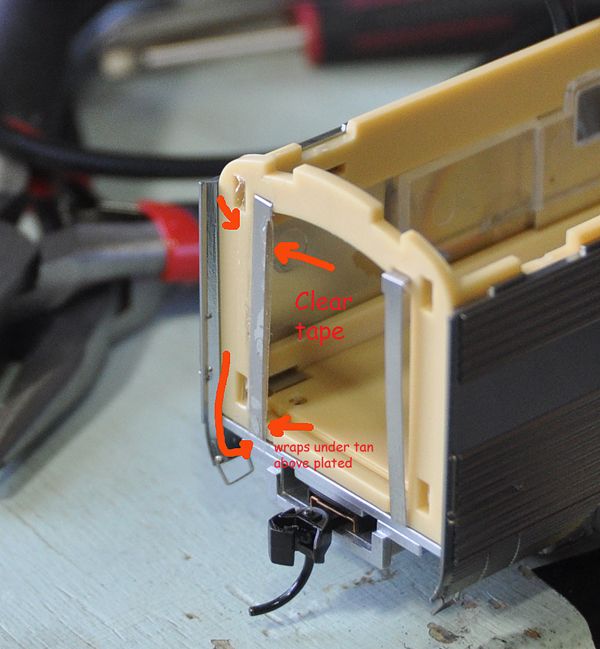 I plan on putting tape on the other side asap just in case. Has anyone taken one of the high level cars apart to check how they're done? oops, I see Larry did after posting. The car was much easier to access the innards than any prior Walthers pax car I've taken apart. |
|
|
|
Post by SantaFeJim on Jun 2, 2012 12:11:23 GMT -8
I have just sent a link to this topic to Walthers Customer Service along with the following email.
[/u] Please see this topic from the ARF HO Forum. Then let me know what your plans are to address this problem.
I was one of the people that purchased the Deluxe addition and I would really regret spending over $1,000 for cars that can not be run.
atlasrescueforum.proboards.com/index.cgi?board=hoforum&action=display&thread=190
Thank you.
James Marek
jamesmarek@sbcglobal.netI will post their response as soon as it is received.
|
|
|
|
Post by calzephyr on Jun 2, 2012 13:42:58 GMT -8
I took my baggage dorm apart and there is only tape on one side. I haven't put it on track yet.  I plan on putting tape on the other side asap just in case. Has anyone taken one of the high level cars apart to check how they're done? oops, I see Larry did after posting. The car was much easier to access the innards than any prior Walthers pax car I've taken apart. Yes, I have taken several of the High level cars apart and they are not designed like the low level cars. Their power is run up to in the middle of the car and not the ends where they can short out. Only the baggage dorm, the baggage and the RPO would use this flawed method that might short out. I am not sure the baggage or the RPO was ever fitted for lights. Jim has sent an email to Walthers with the forum post link and I have done that also so at least two emails concerning this problem have been sent off. I would encourage others to send an email to Walthers to gain some quick attention to this problem. The pictures sure prove there is a problem, but we will not hear anything until after the weekend. I did receive the auto notice that they send out when they get the message. |
|
|
|
Post by calzephyr on Jun 2, 2012 14:06:14 GMT -8
This is an FYI about the low level Super Chief train, I checked several of the cars and diagrams and all that have lighting use the voltage flat vertical lines at the end just like the Baggage dorm that shorted out. If any of the orginal plated Super Chief cars does not have tape on the voltages tabs, they could short out also. All of those cars have that same potential to short.
It would be advisable to pop the ends off of the car and install tape on both of the metal leads, just to be sure and safe. One side will prevent the short circuit, but if you take them off, you might as well fix it correctly.
Larry
|
|
|
|
Post by calzephyr on Jun 2, 2012 14:33:58 GMT -8
This is an FYI about the low level Super Chief train, I checked several of the cars and diagrams and all that have lighting use the voltage flat vertical lines at the end just like the Baggage dorm that shorted out. If any of the orginal plated Super Chief cars does not have tape on the voltages tabs, they could short out also. All of those cars have that same potential to short. It would be advisable to pop the ends off of the car and install tape on both of the metal leads, just to be sure and safe. One side will prevent the short circuit, but if you take them off, you might as well fix it correctly. I just checked the 73" baggage car and it has the lighting voltage leads in one end of the car. It should be insulated also or remove the vertical leads if no lighting is wanted. The RPO is still an unknown so if anyone has one in hand, check the parts diagram and see if it has the verical voltage leads. Larry |
|
|
|
Post by el3637 on Jun 2, 2012 20:28:34 GMT -8
So they intended to tape only one side... still not sure why mine shorted since it did have the tape on one side, and it was the untaped side that shorted. So I'm not sure how it contacted the other side unless there was just a hole in the tape.
At any rate, it seems like Walthers was at least aware of the conductivity of the plating and took a step to prevent a short, but in my case something went wrong. Sort of like the little piece of masking tape on the bottom of Athearn BB motors that prevents the motor base from contacting the frame... if it does, and you're running DCC - bye bye decoder.
Andy
|
|
|
|
Post by rhpd42002 on Jun 3, 2012 5:22:51 GMT -8
Andy, it will be interesting to see if they give you a response and if so, what it will be. Also, in looking at the exterior damage to your car, it appears to look like damaged metal, as if something struck it in the yard.  |
|
|
|
Post by SantaFeJim on Jun 3, 2012 5:36:17 GMT -8
If anybody else would like to send an email Walthers about this issue, please feel free to include your comments.
Their Customer Service address is: custserv@walthers.com
|
|
|
|
Post by antoniofp45 on Jun 3, 2012 9:22:32 GMT -8
re real metal plating and smoking non-smoker cars.... "Don't you think this prototype [stuff} dun got outta hand?" - Waylon Waymore  Sorry, just had to say it after all the discussion over whose plating is best, is it real plating? etc.........................  ;D Hello Waylon, I'm typing this as if I was having a friendly discussion with fellow modelers.
"Don't you think this prototype stuff dun got outta hand?"
Waylon, remember that for the past 2 decades scale model railroaders, collectively, have been constantly demanding that our hobby's manufacturers produce more precise, more prototype specific, better detailed models. By the mid 1980s, many of us were complaining about the old "Athearn Blue Box approach" (producing large batches of semi-generic rolling stock and slapping on a variety of roadnames, whether there was a prototype or not for each model). So how has it gotten out of hand? Of course, many of use did not foresee the hard economic changes that resulted in outsourcing and limited runs.
Plating:
I was involved in a number of SS/plating related discussions on several forums. You might have seen a number of my detailed responses that included my research.
Walthers (and likely, Rapido) have their hands tied as it would be cost prohibitive to produce plated cars with various tonal finishes. So they have to go with one.
When Walthers produced the beautiful Pine and Regal series cars, to my surprise, a number of modelers complained to Walthers about the finishes. Yet, according to my research the finishes were not far off the mark in resembling Austenitic stainless steel exhibiting a #7 reflective finish with a medium to dark tone. I knew that the opinions were subjective, yet I wondered how many of these modelers bothered to compare the finishes to samples of real 300 series SS with a reflective finish.
So recently Walthers changed its formula. Some modelers like it, some don't. Difficult to make everyone happy. Does it resemble real SS? Imho, the answer would still be yes. However, it resembles SS that has aged a number of years but has been generally kept clean, (which the Santa Fe did) so it's also quite realistic, especially for modeling from the 1960s thru early Amtrak.
Prototypically, there are many photos that have shown SS cars within the same train, from the same manufacuturer with finishes that don't match exactly. I've posted a number of photos of this and Jason Shron had some excellent photos of 3 Budd units coupled together, each with a completely different SS appearance. Age, maintenance, wash cycles, the route the units run on are factors that affect appearance.
Makes me almost scratch my head sometimes when I read of modelers that don't want to run Pine units with the new El Cap units. As you saw on my recent Alclad thread, I run worn SS finished units mixed with well-maintained finished SS units within the same train without a second thought. The prototype railroads certainly did.
Now, I may get some tomatoes thrown at me, but a personal critique I still keep in mind but seldom vocalize: Every plated model owned by modelers that I've seen on YouTube, on the forums, and in magazine photos is unweathered. Even the Santa Fe Super Chief and California Zephyr got a bit grimy on the undersides and on the ends. I hope to see modelers adding that touch of realism on to their units in the near future. 
|
|
|
|
Post by calzephyr on Jun 3, 2012 16:07:55 GMT -8
My cars are now safe. Since I do not use lighting in any of my cars, I removed the coupler, removed the end of the car, loosen the truck so the body could be sparated from the bottom and pulled the vertical leads out of the car. They just snap out of place. No need to worry about them now as no voltage is available at the ends to short out. I certainly don't say to do this is you ever want lighting, but it is quick and easy to fix the problem is lighting is not wanted. It took about ten minutes per car.
Larry
|
|
|
|
Post by el3637 on Jun 6, 2012 11:26:06 GMT -8
I just sent a note to Walthers customer service with links to the pics, although I know they've already seen them. I'm not asking for a replacement car - just a replacement for the damaged car end. I know I'm probably entitled to a replacement car but I just don't feel like sending the whole thing back especially after I've modified it. Hopefully they have at least SOME parts on hand - I guess I'll find out.
Andy
|
|

























